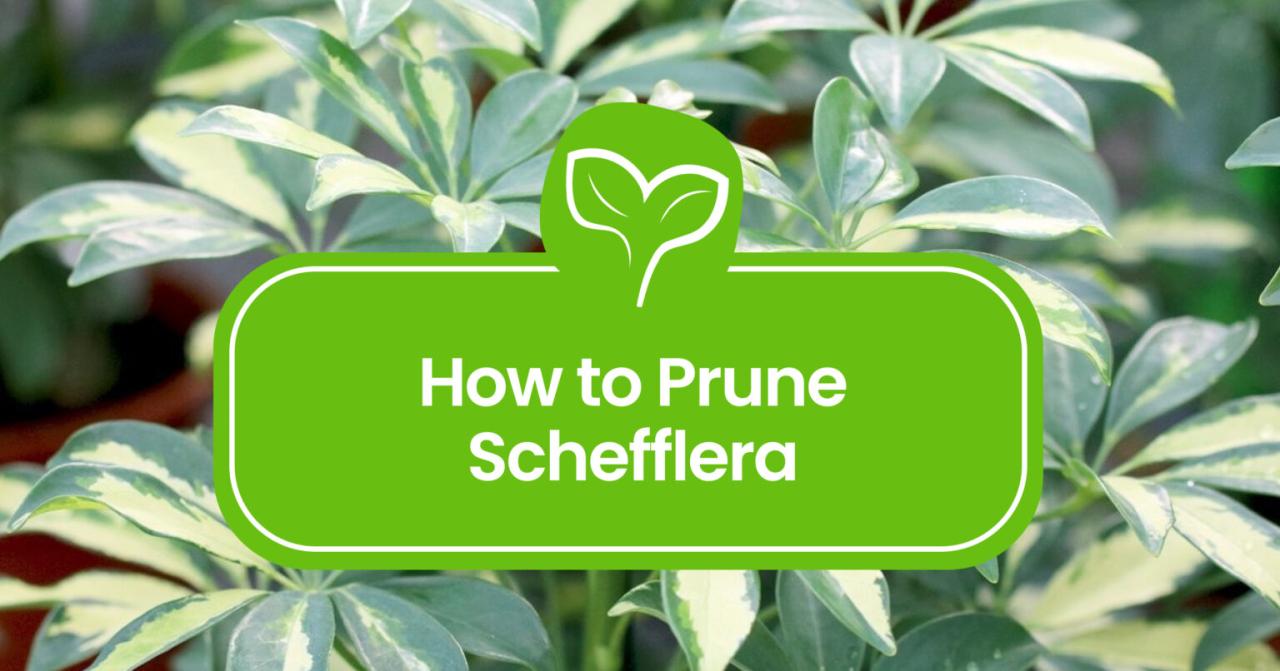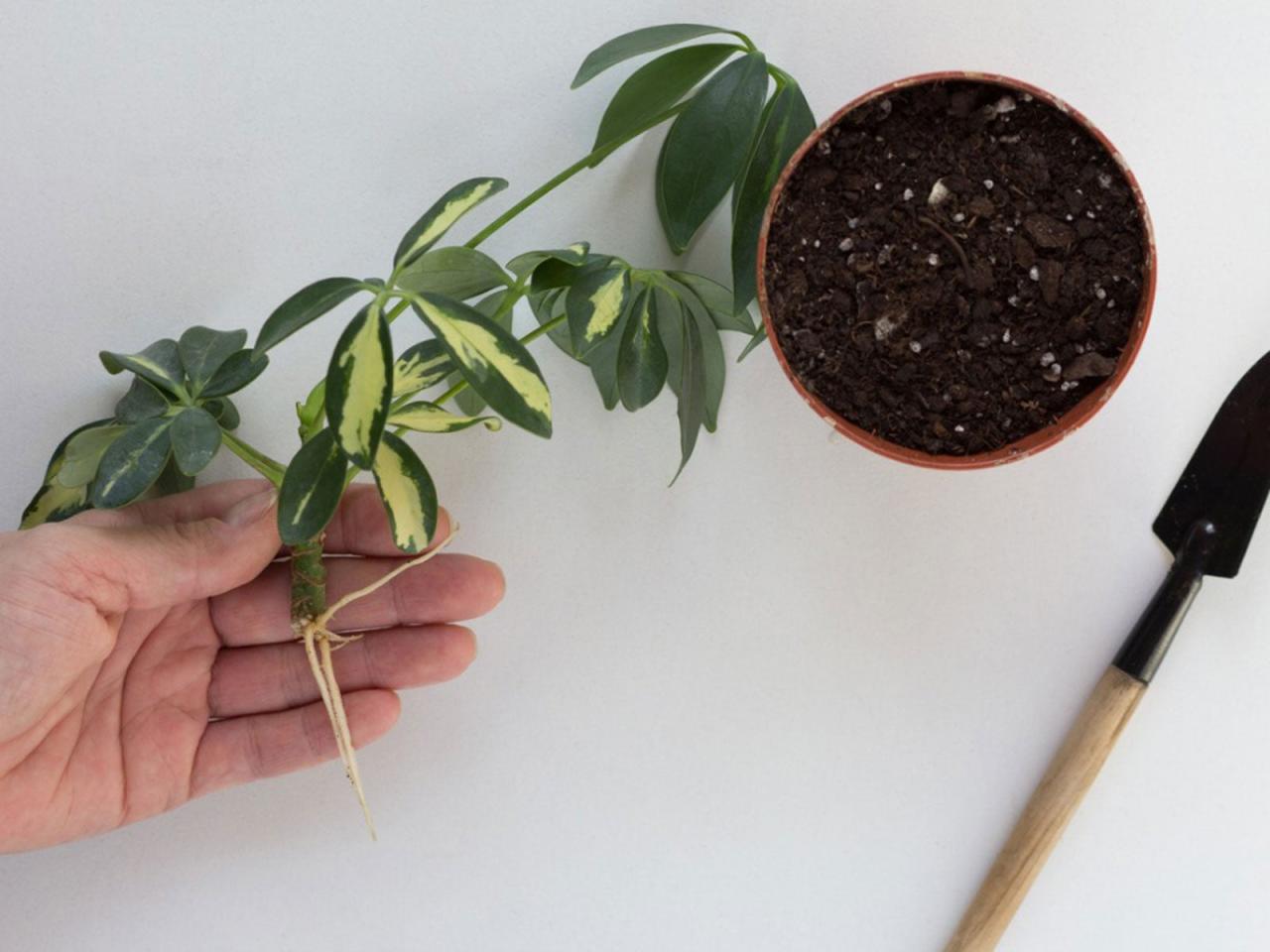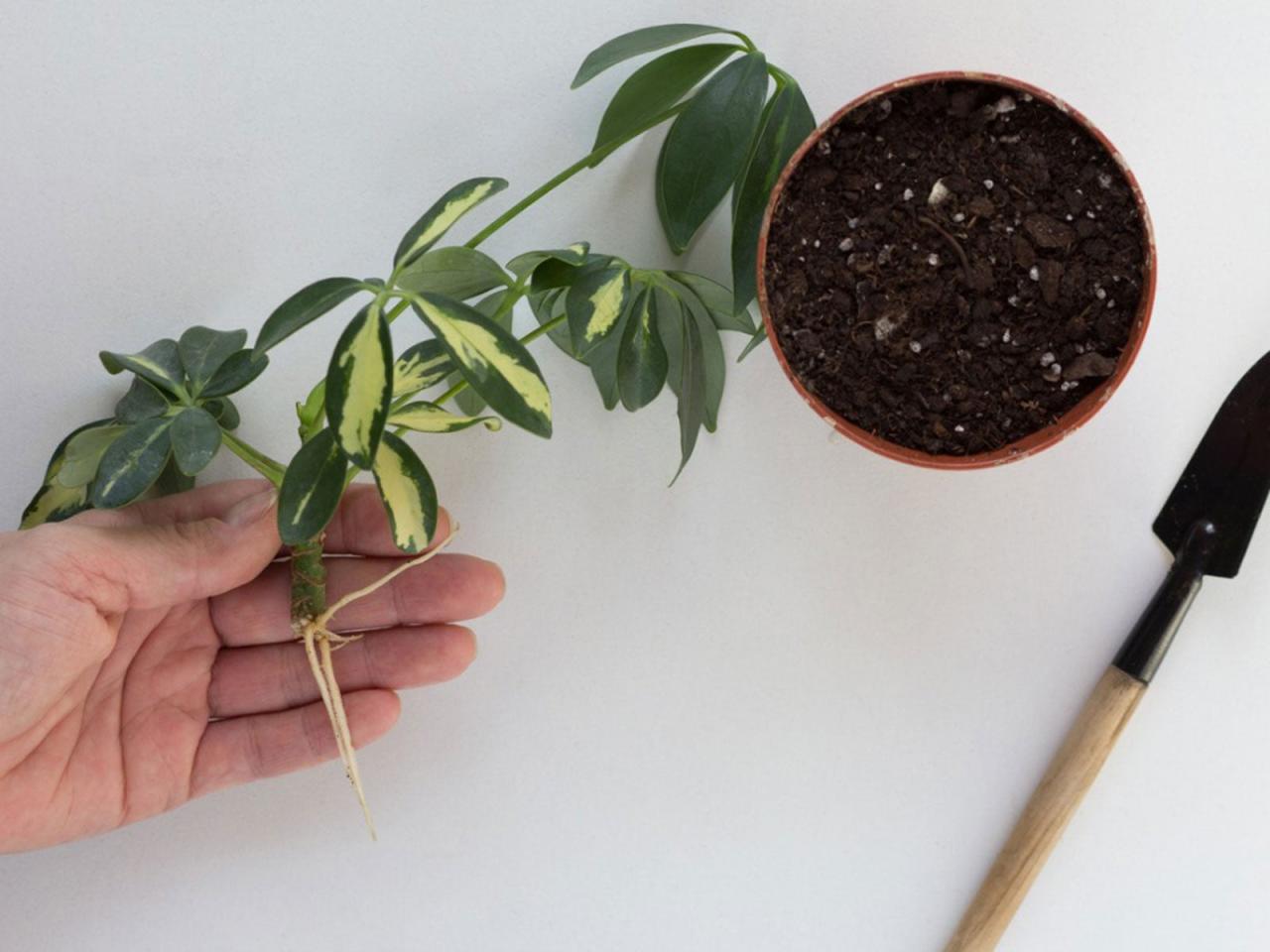The Complete Guide to Mastering Schefflera Propagation at Home sets the stage for this enthralling narrative, offering readers a glimpse into a story that is rich in detail with search engine journal author style and brimming with originality from the outset.
Schefflera plants, also known as umbrella trees, are popular houseplants renowned for their lush, vibrant foliage. Their captivating appearance makes them a favorite among plant enthusiasts, but the joy of owning these plants extends beyond their aesthetics. The ability to propagate Schefflera at home unlocks a world of possibilities, allowing you to create new plants, share them with friends, and even build a thriving collection.
This comprehensive guide explores the various methods of Schefflera propagation, providing step-by-step instructions and valuable tips to ensure success.
Introduction to Schefflera Propagation
Schefflera plants, commonly known as umbrella trees, are popular houseplants renowned for their attractive, feathery foliage and relatively easy care. Their ability to thrive in a variety of indoor conditions makes them a favorite among plant enthusiasts. Propagating Schefflera plants at home offers numerous benefits.
It allows you to expand your plant collection without spending a fortune on new plants. You can also share your success with friends and family, giving them the opportunity to enjoy these beautiful plants. Additionally, propagation can be a fun and rewarding experience, connecting you with the natural world and fostering a deeper appreciation for plant life.
Methods of Schefflera Propagation
There are several methods of Schefflera propagation that you can utilize at home, each with its own advantages and disadvantages. The most common methods include:
- Stem Cuttings:This method involves taking cuttings from the stems of an established Schefflera plant and rooting them in water or soil. Stem cuttings are a simple and effective method, making them ideal for beginners.
- Air Layering:Air layering involves creating a wound on a stem and wrapping it in moist sphagnum moss to encourage root development. This method is particularly useful for propagating larger Schefflera plants or those with thicker stems.
- Seed Propagation:While less common, Schefflera plants can also be propagated from seeds. This method requires more patience and time, but it can be rewarding for those who enjoy starting plants from scratch.
Propagation by Stem Cuttings

Stem cuttings are a popular and relatively simple method for propagating Schefflera plants. This method involves taking sections of healthy stems and encouraging them to develop roots, ultimately leading to the creation of new, independent plants.
Preparing Stem Cuttings
Preparing stem cuttings involves selecting healthy stems, making clean cuts, and removing lower leaves.
- Selecting Healthy Stems:Choose stems that are firm, disease-free, and have a healthy green color. Avoid stems that are wilted, discolored, or have signs of pests or diseases.
- Making Clean Cuts:Use a sharp, clean knife or pruning shears to make a clean, angled cut just below a node (the point where a leaf or branch grows). This angled cut provides a larger surface area for root development.
- Removing Lower Leaves:Remove the leaves from the bottom 2-3 inches of the stem. This prevents the leaves from rotting in the rooting medium and encourages the plant to focus its energy on root development.
Creating a Rooting Medium
A rooting medium is essential for providing the right environment for root development. A mixture of perlite and vermiculite is an excellent choice for Schefflera cuttings.
- Perlite and Vermiculite Mixture:Perlite and vermiculite are lightweight, porous materials that provide good drainage and aeration. A 1:1 ratio of perlite to vermiculite is ideal for rooting Schefflera cuttings. This mixture allows for adequate air circulation, prevents waterlogging, and promotes healthy root growth.
Planting and Maintaining Humidity
After preparing the cuttings and rooting medium, it’s time to plant the cuttings and maintain proper humidity.
Whether you’re a seasoned gardener or just starting out, mastering Schefflera propagation can be a rewarding experience. From cuttings to air layering, there are several methods to explore, each with its own unique advantages. For inspiration and a taste of the season, check out Explore Harvest Moon Orchard: Your Guide to Seasonal Fun before diving into your propagation project.
You’ll find that the knowledge gained from understanding the rhythms of nature can be applied to successfully nurturing your Schefflera plants.
- Planting the Cuttings:Fill a pot or tray with the perlite-vermiculite mixture. Make small holes in the medium, spacing them apart according to the size of the cuttings. Gently insert the cuttings into the holes, ensuring that the cut end is fully submerged in the rooting medium.
Firmly press the medium around the cuttings to secure them in place.
- Maintaining Humidity:Schefflera cuttings require high humidity to encourage root development. To create a humid environment, cover the pot or tray with a plastic dome or a clear plastic bag. This traps moisture and creates a greenhouse-like effect. Ensure that the plastic dome or bag has some ventilation to prevent condensation buildup.
Tips for Successful Root Development
- Consistent Moisture:Keep the rooting medium consistently moist but not waterlogged. Regularly check the moisture level and water as needed. The medium should feel slightly damp to the touch. Avoid overwatering, as this can lead to root rot.
- Warm Temperatures:Schefflera cuttings thrive in warm temperatures. An ideal temperature range for root development is between 70-75 degrees Fahrenheit (21-24 degrees Celsius). Keep the cuttings in a warm location, away from drafts and direct sunlight.
- Bright, Indirect Light:Provide the cuttings with bright, indirect light. Avoid exposing them to direct sunlight, which can scorch the leaves. A sunny windowsill with a sheer curtain or a well-lit area with artificial light is suitable.
- Patience:Root development can take several weeks or even months. Be patient and monitor the cuttings regularly for signs of new growth. Once new growth appears, it indicates that the cuttings have successfully rooted.
Propagation by Air Layering
Air layering is a propagation technique that involves inducing root growth on a stem while it’s still attached to the parent plant. This method is particularly useful for schefflera, as it allows you to create new plants without having to cut off a stem completely.
Advantages of Air Layering
Air layering offers several advantages over other propagation methods:
- It allows you to propagate plants that are difficult to root from cuttings.
- It can be used on mature plants, providing you with a way to rejuvenate or multiply older schefflera.
- The new plant develops a strong root system, making it more resilient and less prone to transplant shock.
Steps Involved in Air Layering
Air layering involves a series of steps that encourage root development on a stem:
- Select a stem: Choose a healthy, mature stem that is at least 1/2 inch in diameter and has no signs of disease or damage.
- Make an incision: Using a sharp knife or pruning shears, make a circular incision around the stem, about 1/2 inch deep. Avoid cutting all the way through the stem.
- Apply rooting hormone: After making the incision, apply a rooting hormone powder or gel to the exposed area. This helps to stimulate root growth.
- Wrap the incision: Wrap the incision with moistened sphagnum moss, ensuring the moss is in contact with the cut surface. The moss provides a humid environment for root development.
- Secure the moss: Secure the moss in place with plastic wrap or aluminum foil, making sure the wrapped area is completely sealed. This helps to retain moisture and humidity.
- Maintain moisture: Keep the sphagnum moss consistently moist by periodically misting it with water. Avoid overwatering, as this can lead to rot.
- Monitor root development: After a few weeks, check for root development by gently pulling on the plastic wrap. If you feel resistance, it indicates root formation.
- Separate the new plant: Once the roots are well-developed, carefully cut the stem below the wrapped area. Remove the plastic wrap and sphagnum moss. You now have a new schefflera plant ready to be potted.
Maintaining Moisture and Humidity
Maintaining a consistently moist and humid environment around the wrapped area is crucial for successful air layering. The sphagnum moss should be kept moist, but not soggy. Regular misting with water is essential. You can also place the wrapped area in a plastic bag or create a mini-greenhouse to help retain moisture.
Monitoring Root Development
After a few weeks, check for root development by gently pulling on the plastic wrap. If you feel resistance, it indicates root formation. You can also try to gently remove a small portion of the moss to check for roots.
If the roots are well-developed, you can proceed with separating the new plant.
Separating the New Plant
Once the roots are well-developed, carefully cut the stem below the wrapped area. Remove the plastic wrap and sphagnum moss. Plant the new schefflera in a pot filled with well-draining potting mix. Water the plant thoroughly and place it in a bright, indirect light location.
Propagation by Seeds
While Schefflera can be propagated through seeds, it is not the most common or efficient method. This is because Schefflera seeds are often difficult to obtain, and germination rates can be inconsistent. However, if you are interested in trying this method, it can be a rewarding experience.
Collecting and Preparing Seeds
Schefflera seeds are typically found within the small, berry-like fruits that develop on mature plants. These fruits turn from green to red or purple as they ripen. To collect seeds, you can simply pick the ripe fruits and gently squeeze them to extract the seeds.
The seeds should be cleaned thoroughly to remove any remaining fruit pulp. You can do this by rinsing them in water and allowing them to dry completely. Once dry, the seeds are ready for planting.
Mastering the art of Schefflera propagation is a rewarding journey for plant enthusiasts, offering a chance to multiply your collection and share the joy of these vibrant foliage plants. As you delve into the intricacies of rooting cuttings and nurturing new growth, remember to take a moment to appreciate the bounty of nature, just like you would at Harvest Moon Orchard.
The experience of tending to your Schefflera plants, watching them flourish, and witnessing new life emerge is a testament to the beauty and wonder of the natural world.
Sowing Schefflera Seeds
You can sow Schefflera seeds in a seed tray or a small pot filled with a well-draining seed-starting mix.
- Make small indentations in the soil, about 1/4 inch deep, and place one seed in each indentation.
- Cover the seeds with a thin layer of soil and gently water them.
- Place the seed tray or pot in a warm, bright location, but out of direct sunlight.
Maintaining Optimal Growing Conditions
It is crucial to maintain optimal growing conditions for seed germination. This involves providing adequate warmth, moisture, and light.
- Keep the soil consistently moist, but not waterlogged.
- Maintain a temperature between 70-75 degrees Fahrenheit.
- Provide bright, indirect light.
Schefflera seeds typically take several weeks to germinate. Be patient and continue to provide consistent care during this time. Once the seedlings emerge, they can be transplanted into individual pots when they are large enough to handle.
Care and Maintenance of Newly Propagated Schefflera Plants
After successfully propagating your Schefflera plants, it’s crucial to provide them with the right care and maintenance to ensure their healthy growth and development. Just like any new plant, newly propagated Schefflera plants require specific conditions to thrive.
Light and Water Requirements
Providing adequate light and water is essential for the successful establishment of newly propagated Schefflera plants. These plants thrive in bright, indirect light and require consistent moisture, but not soggy soil. Newly propagated plants are particularly sensitive to environmental changes, so it’s crucial to provide them with the right conditions to help them acclimate and establish strong roots.
Fertilizer Application
Fertilizer plays a vital role in promoting healthy growth in newly propagated Schefflera plants. While they don’t require heavy fertilization, a balanced liquid fertilizer diluted to half strength can be applied every two to three weeks during the growing season.
Fertilizing helps provide the essential nutrients needed for root development and foliage growth.
Repotting Young Plants
As newly propagated Schefflera plants grow larger, they may require repotting to accommodate their expanding root systems. Repotting should be done when the roots become overcrowded in the current container, which is usually indicated by roots emerging from the drainage holes.
Choose a pot that is only slightly larger than the previous one to avoid over-potting, which can lead to waterlogging and root rot.
Protecting Plants from Pests and Diseases
Newly propagated Schefflera plants are susceptible to pests and diseases, especially when their immune systems are still developing. Regularly inspecting plants for signs of infestation or disease is crucial for early detection and treatment. Common pests include spider mites, aphids, and mealybugs, while common diseases include root rot and leaf spot.
Using a mild insecticidal soap or neem oil spray can effectively control pests, while proper watering techniques and good air circulation can help prevent diseases.
Troubleshooting Common Propagation Issues

While propagating Schefflera is generally straightforward, certain challenges can arise. Identifying and addressing these issues promptly can ensure successful propagation and healthy plant growth. This section explores common problems encountered during Schefflera propagation and provides solutions and preventative measures to ensure your success.
Root Rot
Root rot is a common problem that can affect Schefflera propagation, particularly when cuttings are kept in overly moist conditions. Root rot occurs when fungi or bacteria thrive in waterlogged soil, damaging the roots and preventing them from absorbing nutrients.Here are some signs of root rot:
- Wilting leaves, even when the soil is moist.
- Black or brown, mushy roots.
- A foul odor emanating from the soil.
Here are some preventative measures to avoid root rot:
- Use well-draining potting mix that allows excess water to drain away.
- Avoid overwatering, allowing the soil to dry slightly between waterings.
- Ensure the propagation container has drainage holes to prevent waterlogging.
If you suspect root rot, here are some steps you can take:
- Remove the cutting from the soil and inspect the roots. If the roots are mushy or black, trim away the affected areas using sterilized scissors or a knife.
- Repot the cutting in fresh, well-draining potting mix.
- Consider using a fungicide or bactericide to help prevent further infection.
Fungal Infections, The Complete Guide to Mastering Schefflera Propagation at Home
Fungal infections can also affect Schefflera cuttings during propagation. These infections can be caused by high humidity, poor air circulation, or contaminated soil.Here are some signs of fungal infections:
- Dark spots or lesions on leaves and stems.
- White, powdery mildew on leaves.
- Leaf drop.
Here are some preventative measures to avoid fungal infections:
- Use sterile propagation tools and potting mix to reduce the risk of contamination.
- Ensure good air circulation around the cuttings to prevent humidity buildup.
- Avoid overwatering and allow the soil to dry slightly between waterings.
If you suspect a fungal infection, here are some steps you can take:
- Remove infected leaves or stems to prevent the spread of the infection.
- Treat the cuttings with a fungicide specifically designed for Schefflera plants.
- Improve air circulation and reduce humidity levels around the cuttings.
Slow Growth
Slow growth in Schefflera cuttings can be caused by several factors, including inadequate light, insufficient nutrients, or improper watering.Here are some signs of slow growth:
- Cuttings that are not producing new leaves or roots.
- Stunted growth or yellowing leaves.
Here are some tips to encourage faster growth:
- Ensure the cuttings are receiving adequate light. Place them in a bright, indirect location or under a grow light.
- Use a well-balanced fertilizer specifically formulated for Schefflera plants.
- Water the cuttings regularly, allowing the soil to dry slightly between waterings.
Last Recap
Mastering Schefflera propagation at home empowers you to unlock the secrets of plant reproduction and create stunning additions to your indoor garden. From the simplicity of stem cuttings to the intrigue of air layering, this guide has equipped you with the knowledge and techniques to embark on this rewarding journey.
Remember, patience and consistent care are key to achieving successful propagation. As you nurture your newly propagated Schefflera plants, you’ll witness the magic of growth and the satisfaction of creating life. So, gather your tools, embrace the process, and enjoy the journey of propagating your own Schefflera plants.
FAQ Compilation: The Complete Guide To Mastering Schefflera Propagation At Home
How often should I water my newly propagated Schefflera plants?
Water your newly propagated Schefflera plants when the top inch of soil feels dry to the touch. Avoid overwatering, as it can lead to root rot.
What type of fertilizer should I use for my propagated Schefflera plants?
Use a balanced liquid fertilizer diluted to half strength during the growing season. Avoid fertilizing during the winter months when the plant is dormant.
What are some common pests that can affect Schefflera plants?
Common pests include spider mites, mealybugs, and aphids. Inspect your plants regularly for signs of infestation and treat promptly with an appropriate insecticide.
How do I know if my Schefflera cutting is rooting?
You can gently tug on the cutting to see if it has developed roots. If it offers resistance, it is likely rooting. You can also look for new growth emerging from the cutting.
